TRAP
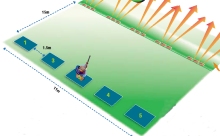 |
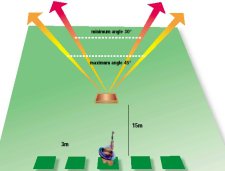 |
Targets are thrown either as singles or doubles from one or more traps situated some 15m in front of the shooter and are generally going away from the firing point at varying speeds, angles and elevations. The most common disciplines in this group are:- Down-the-Line (DTL) Single Barrel, Double Rise, Automatic Ball Trap (ABT), Olympic Trap, Double Trap and Universal Trench.
OLYMPIC TRAP
As its name indicates, this is one of the disciplines which form part of the shooting programme at the Olympic Games. A trench in front of the shooting stands conceals 15 traps arranged in 5 groups of 3. Shooters take turns to shoot at a target each, before moving in a clockwise direction to the next stand in the line. Targets for each shooter are thrown immediately upon his call and are selected by a shooting scheme that ensures all competitors receive exactly the same target selection, but in a unpredictable randomised order, from any one of the three traps directly in front of him. Olympic Trap targets are set to travel 75 to 80 metres at varying elevations and with a maximum horizontal angle of 45 degrees either side of the centre line. Scoring is done of the basis of 1 point per target killed, regardless of whether this is achieved with the first or with the second barrel. A simpler and cheaper to install variation of this discipline is known as AUTOMATIC BALL TRAP (ABT) where only one trap is used and target variation is obtained by the continuous oscillation of the trap in both horizontal and vertical directions in order to give the same spread of targets as in Olympic Trap. Similarly, the targets are also thrown to a maximum of 80 metres.
SKEET
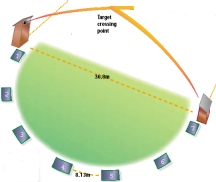 |
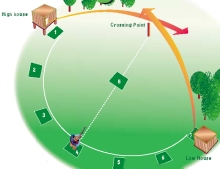 |
Skeet is a word of Scandinavian origin, though the discipline originated in America. Targets are thrown in singles and doubles from 2 trap houses situated some 40 metres apart, at opposite ends of a semi-circular arc on which there are seven shooting positions. The targets are thrown at set trajectories and speeds. The main disciplines in this group are English Skeet, Olympic Skeet and American (NSSA) Skeet.
In this discipline, targets are released in a combination of singles and doubles, adding up to a total of 25 targets per round, from the High and Low trap houses on a fixed trajectory speed. Variety is achieved by shooting round the seven stations in a semicircle. Scoring is on the basis of 1 point per target killed, up to a maximum of 25.
In ENGLISH SKEET (by far the most popular of the skeet disciplines), the gun position is optional (i.e. pre-mounted or out-of-shoulder when the target is called) and the targets are released immediately upon the shooter’s call.
In OLYMPIC SKEET, the targets travel at a considerably faster speed, the release of the target can be delayed up to 3 seconds after calling and the gun-down position is compulsory. There is also an eighth shooting station, midway between the two houses.
SPORTING
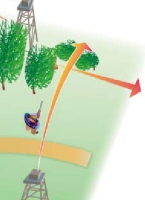 |
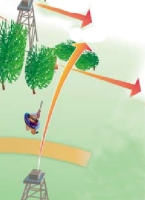 |
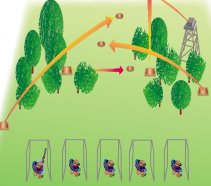 |
This discipline can have an infinite variety of ‘stands’ . ENGLISH SPORTING is the most popular form of clay shooting in the UK, and a course or competition will feature a given number of stands each of which has a predetermined number of targets, all travelling along the same path and speed, either as singles or doubles.
Each stand will feature a different type of target i.e. crosser, driven, quartering etc. INTERNATIONAL (FITASC) SPORTING gives a much greater variety of targets in terms of trajectory and speed, and is shot by squads of six competitors in rounds of 25 targets at a time. Super Sporting is a hybrid of the two preceding varieties. There are also other formats such as Compak Sporting and Sportap in which five cages are surrounded by a number of traps, and shooters fire a specific combinations or singles from each stand according to a program displayed in front of the cage.
DOWN THE LINE (DTL)
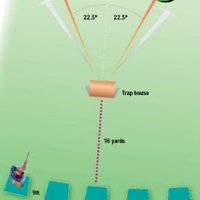
Also known as DTL, this is a popular clay shooting discipline. Targets are thrown to a distance of 45 to 50 metres at a fixed height of approximately 2.75m and with a horizontal ‘spread’ of up to 22 degrees either side of the centre line. Each competitor shoots at a single target in turn, but without moving from the stand until he or she have all shot five targets. Then they all move one place to the right, and continue to do so until they have all completed a standard round of 25 birds. Scoring of each target is 3 points for a first barrel kill, 2 points for a second barrel kill and 0 for a miss (maximum 75 points per round). Variations of this discipline are: Single Barrel, Double Rise and Handicap-by-Distance.
UNIVERSAL TRENCH
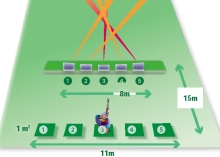
A variation on the theme of trap shooting, sometimes known as “Five Trap” five traps are installed in a trench in front of the shooting stands, all set at different angles, elevations and speeds, and upon the call of “Pull!” by the shooter any one of the five machines, selected at random, will be released.
Horizontal angles can vary from 0 degrees to 45 degrees either side of the centre line and target distance is between 60 and 70 metres. Elevations can vary, as in other trap disciplines (except DTL), between 1.5 and 3.5 metres above ground level.
HELICE (ZZ)
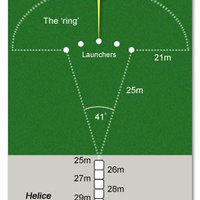 |
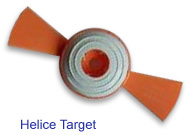 |
A different form of flying target competition, which cannot be called clay shooting as the targets are made up of an orange or red, two winged propeller shape with a detachable white centre cap known as the ‘witness’ Plastic propellers holding a detachable centre piece are rotated at high speed and released randomly from one of five traps. They fly out with in an unpredictable way “buzzing” through the air to give the discipline its colloquial name of ZZ. It is designed specifically to simulate as closely as possible the old sport of live pigeon shooting which was made illegal in this country more than 70 years ago. It is great fun to shoot, but can also be a very competitive sport with World and European Championships being held on the continent every year.
The shooter can take two shots at each target but both shots must be made during the acceleration phase of the helice. To score a hit, the white centre cap must separate completely from the wings and it must land within the fenced area known as the ‘ring’ (see below).
Once a shooter is stood on the shooting stand he/she can load their gun and the launchers will be started. The shooter must then indicate when they are ready to call for a target by shouting “ready”, the ‘puller’ will then activate the voice release mechanism and shout “ready” in return. The shooter is then free to call for the helice which will be released immediately upon their call.
Helice layouts are made up of five or seven launchers, when the shooter calls for a target it will be released from one of the launchers at random. The shooter does not know which launcher will throw the target until the white door of the machine falls open and the helice is released.
Most events are shot over 25 targets with shooters attempting two targets per go on five machine layouts and three targets per go on seven machine layouts.
Helice targets are thrown using special launchers made from small oscillating electric motors that spin the targets at high speed (up to 10,000 rpm) before releasing them. There are five or seven, evenly spaced, launchers set in an arc 25m in front of the front shooting stand. The stands range from 25m to 30m.
When there are five launchers they are set 4.5m-5.0m apart, this is reduced to 2.25m-2.50m apart when there are seven launchers.
A rigid fence is set up 21m from the point where the helices are launched, this is known as the ‘ring’.
It used to be possible to use up to 36g cartridges at Helice competitions, however from 1st Jan 2010 it was changed to cartridges with a maximum load of 28g and a shot size no greater than 2.7mm.
